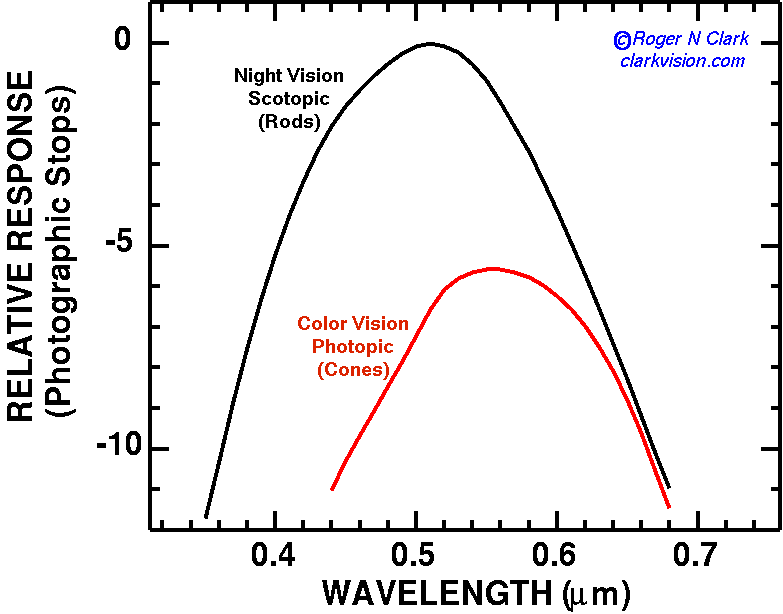| Home | Galleries | Articles | New | About | Contact |
| Home | Galleries | Articles | New | About | Contact |
Maintaining good night vision is critical for observing faint subjects, whether distant galaxies, reading charts and observing guides, operating telescopes and cameras or even walking a trail in starlight with minimal lights. Some tasks like, reading star charts, does require some additional light than just star light.
The common night observing light is a red light. But I have often observed that the red lights people use are so bright they will significantly harm night vision. A bright light of any color, when it is so bright that one actually sees strong color is probably too bright. The rods (night or scotopic vision) are more sensitive to light than are the cones (photopic vision) at ALL wavelengths (Figure 1). The data in Figure 1 shows that simply because a light is red, it can still harm night vision if too bright.
The keys to a good light for night work is that is must be DIM, and it should not be blue. Strong colors warp color perception, so do not use strongly colored lights, including red. I use yellow or orange colors.

Here is a possible way for everyone with a camera that has a lightmeter to check the brightness of their lights:
1) Use a camera with about a 50 mm (equivalent) lens set at f/8, and at ISO 1,000. (lens focal length should not affect the reading significantly.)
2) Place the flashlight right up next to the front of the lens (do not touch the lens--you might scratch it, a few mm away is fine. Shine the light into the camera. In the test I did with my light, the light fills the narrow length of the frame and about 2/3 of the long length, and, of course, it is not in focus.
3) Take an exposure reading in seconds.
I use a flashlight with an incandescent bulb that I've added a reostat to, a 2 cell flashlight with a 4 cell bulb and some paper to make a yellow-orange light. I also use LED flashlights where I have covered the flashlight with brown paper, or brown plastic in several layers to reduce the brightness.
At the light level that I use when deep-sky observing, the camera reads:
4 sec f/8 (ISO 1000)
2 sec f/5.6 (ISO 1000)
1 sec f/4 (ISO 1000)
1/2 sec f/2.8 (ISO 1000)
1/4 sec f/2 (ISO 1000)
1/8 sec f/1.4 (ISO 1000)
2/3 sec f/4 (ISO 1600) (0.6 sec)
1/3 sec f/2.8 (ISO 1600) (0.3 sec)
1/6 sec f/2 (ISO 1600)
1/13 sec f/1.4 (ISO 1600)
At levels of 1/4 sec, the light is way too bright. If you were to walk around and need ground light (flashlight pointed down, from waist level) I would suspect a level of about 1/10 sec would be dim but ok.
What do you get on your lights? Another question here might be how do camera light meters respond to red light? The answer is sensitivity is dropping off, so red readings may be low compared to green-orange. That means that if you do use a red light, then the 4 seconds at f/8 reading may not be accurate and your light is actually brighter.
| Home | Galleries | Articles | New | About | Contact |
This page URL:
http://clarkvision.com/visastro/obslight1.html
First published January 27, 2002 Last updated April 6, 2014